On this page
Back problems affect 7 out of 10 people in their lives but are rarely serious. They are most prevalent in people of working age however not necessarily caused through work.
The majority of lower back problems are referred to as non-specific lower back pain. This means that the back problem is not caused by serious damage or disease but by sprains / muscle strains / minor injuries or irritation of the nerves.
Back pain is most commonly experienced in the lower back, in the area between the ribs and the top of the hips. Symptoms can include aching, burning, shooting, or stabbing pains in your back which can sometimes spread into one or both of your buttocks or legs, occasionally as far as your feet. You may have heard the term ‘sciatica’ used before to describe these kind of leg symptoms.
Very rarely, some people with back pain may develop Cauda Equina Syndrome. This is a very serious complication. If you develop any of the warning signs below following the onset of your back pain, you should attend your nearest accident and emergency department immediately.
You may not develop all of the following signs and they could develop in any order.
Symptoms
- Loss of feeling / pins and needles between your inner thighs or genitals.
- Numbness in or around your back passage or buttocks
- Altered sensation when wiping yourself with toilet paper
- Increasing difficulty when trying to urinate
- Increasing difficulty in stopping or controlling the flow of urine
- Loss of feeling when you urinate or empty your bowels
- Leaking urine or needing to use pads
- Not knowing if your bladder is full or empty
- Inability to stop a bowel movement or leaking
- Change in ability to achieve an erection or ejaculate
- Loss of sensation in genitals during sexual intercourse.
The following symptoms may be serious but less urgent.
We recommend that you contact your GP if you experience:
- Severe pain which is worsening with time
- Unsteadiness on your feet
- Unexplainable weight loss
Investigations
Further investigations such as MRI scans, x-rays or blood tests are not normally needed for most people with back problems. This is because having these investigations does not usually change the management or outcome of the back problem.
For further information please see the current NICE guidance for low back pain and sciatica.
Process of back pain
Most back pain will resolve itself within 6-12 weeks and will not require time off work or medical intervention. See the table below for a typical journey of someone who has a flare up of back pain.
Flare Up of Back Pain (first 1 to 3 days)
| Flare Up of Back Pain (first 1 to 3 days) | |
| What to expect? High levels of pain Difficulty moving/dressing/walking Tight muscles | What should I do? Pain relief- further advice from GP/pharmacy Use hot/cold packs Gentle activity/exercise as tolerated |
| Coming Out of Flare Up (from day 3 to 2 weeks) | |
| What to expect? Slight improvement in pain Stiffness when moving Some activities continue to be painful | What should I do? Continue to use pain relief as required Continue gentle exercise Gradually resume normal activities/hobbies |
| Returning to Normal (from 2 to 12 weeks) | |
| What to expect? Pain and stiffness gradually improving Expect the odd “bad day” | What should I do? Resume all regular activities Engage with cardiovascular (walking, swimming, cycling), strengthening (housework, gardening and stretching exercise to promote back health |
| Moving Forward | |
| Maintain a healthy and balanced lifestyle. The World Health Organisation (2011) recommend 2 ½ to 5 hours of moderate intensity physical activity a week and muscle strengthening activities involving the major muscle groups on 2 or more days a week. Contact the Staff Social Club for more information on local NHS discounted gyms and activities. |
Other influencing factors
Other factors which can impact on the severity and duration of your symptoms may include personal and work-related stress, anxiety, depression, sleep and/or significant life changing events.
Further advice and support is available through the Occupational Health Counselling Service which can be accessed via self-referral through the Occupational Health Services webpage on the trust website.
What can I do to help my symptoms?
Pain relief
Simple analgesia such as Paracetamol and an anti-inflammatory such as Ibuprofen can be very effective in the management of back pain. You can obtain advice regarding medication from your local pharmacist or GP but remember to read the packet; and do not take over the recommended dosage.
Cold or Hot Packs
A cold or hot pack can also be helpful in offering symptomatic relief but must not be directly applied to the skin or to areas of skin that have poor sensation or are numb. A layer of protection (e.g. towel) should be used to cover the cold or hot pack so that it is not in direct contact with the skin.
Do not use ice if you have circulatory problems, such as Raynaud’s disease, history of cold induced hypertension, peripheral vascular disease, allergy to cold (urticaria, joint pain) or sickle cell anaemia.
If your skin is usually numb over the injured area, please speak to your physiotherapist or GP before using a cold pack / ice.
Ice must be used correctly otherwise ice burns can occur. Please see the instructions below:
- Start by wetting a cloth under a cold tap and then wring the cloth out until it is just damp.
- Place the damp cloth over affected area and then place either a plastic bag of crushed ice or a packet of frozen peas on top of the cloth. (The ice should be in small pieces in order to mould better to the area and help prevent ice burns).
- Leave the ice pack and cloth in place for approximately 10-15 minutes and repeat 3 to 4 times a day.
It is normal for your skin to go slightly red or pink. Remove the ice if extreme redness/pain, blistering or an increase in swelling occurs. If this does occur, please call NHS Direct for further advice.
Activity
Staying active is the most important advice when dealing with back pain. Remember spines are very strong and it is very rare that back pain is caused by anything serious. You may need to take things a little easier for a few days but do not take bed rest unless told to by your GP or health care professional.
Instead stay as active as you can and continue with your usual activities as much as possible. Although this will be uncomfortable it does not mean you are doing any damage – hurt is not the same as harm, and will lead to a faster recovery and prevent more problems in the future.
Striking a balance
Initially you may need to take things a little easier or move more carefully. You can still do most activities without putting too much strain on your back.
It is advisable that you do not do too much of any one thing.
- Don’t walk too far, little and often is better than one long walk. It is important that you try to walk as normally as you can and avoid limping. Although it sometimes feels easier to limp, you will cause other muscles to over work which can cause more problems later.
- Don’t sit for too long – get up and change your position. This helps prevent stiffness.
- Jobs around the house may need to be done in a few stages to avoid putting excessive strain on your back. This could mean spreading a job e.g. hoovering over two days instead of doing it all in one go.
- Don’t avoid jobs, just be sensible.
- Take regular breaks when driving.
Initial exercises
Keeping your back moving during a flare up of pain is important. Here are some exercises which may help. A gradual return to your usual physical activities and hobbies is also helpful.
Take a sensible approach to the exercises. For example do the exercises on the bed if you have difficulty getting on and off the floor.
Do not continue the exercises if they significantly increase your pain. If this were to occur, please see your GP or Physiotherapist for further advice.
Each exercise can be done between 5-10 times.
It is best just to do a few then increase the number of repetitions as you feel better.
Performing these exercises three times a day may be more beneficial that just once as they will stop the back stiffening and causing you more pain.


Exercise 1: Pelvic tilt
Lie on your back with your knees bent up and feet flat on the surface beneath you (e.g. floor or bed).
Now press the small of your back down into the surface and tuck your bottom under. If you place your hand under your lower back (as per figure 2) you should feel your hand getting squashed.
Hold for 5 seconds. Return to the starting position
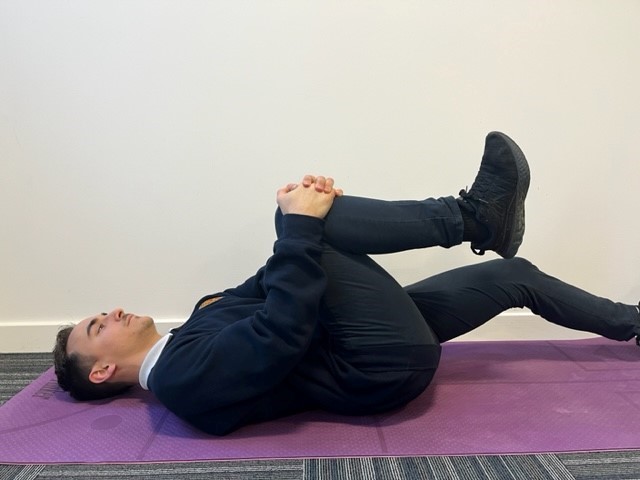

Exercise 2: Single knee hugs
Lie on your back with your knees bent up and feet flat on the surface beneath you (e.g. floor or bed).
Raise 1 leg and gently hug the knee to your chest.
Hold for 5 seconds then return to the start position.
Now repeat with the opposite leg.
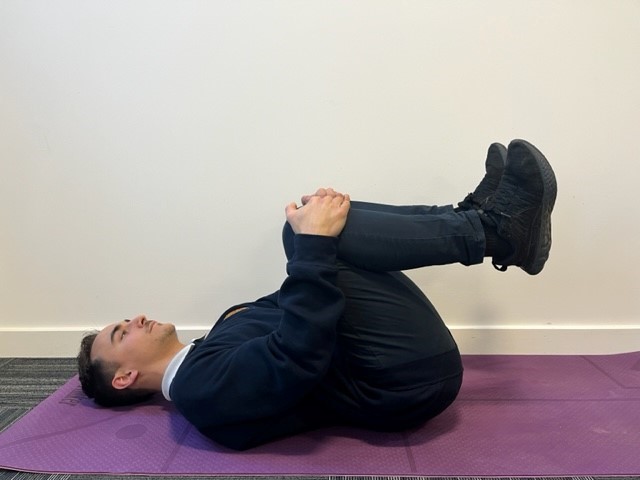

Exercise 3: Double knee hugs
Lie on your back with your knees bent up and feet flat on the surface beneath you (e.g. floor or bed).
Raise both legs and gently hug your knees into your chest.
Hold for 5 seconds.



Exercise 4: Knee rolls
Lie on your back with your knees bent up and feet flat on the surface beneath you (e.g. floor or bed).
Keep your knees together and roll them from side to side as per figures 2 and 3.
Exercise 5: cat stretch
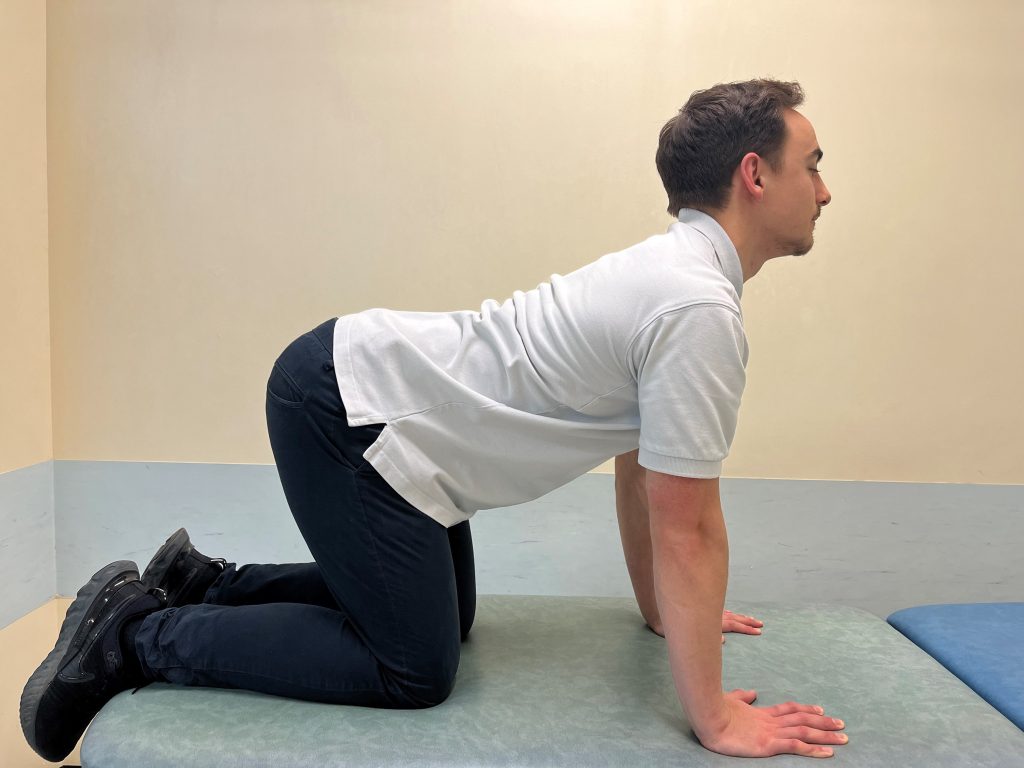
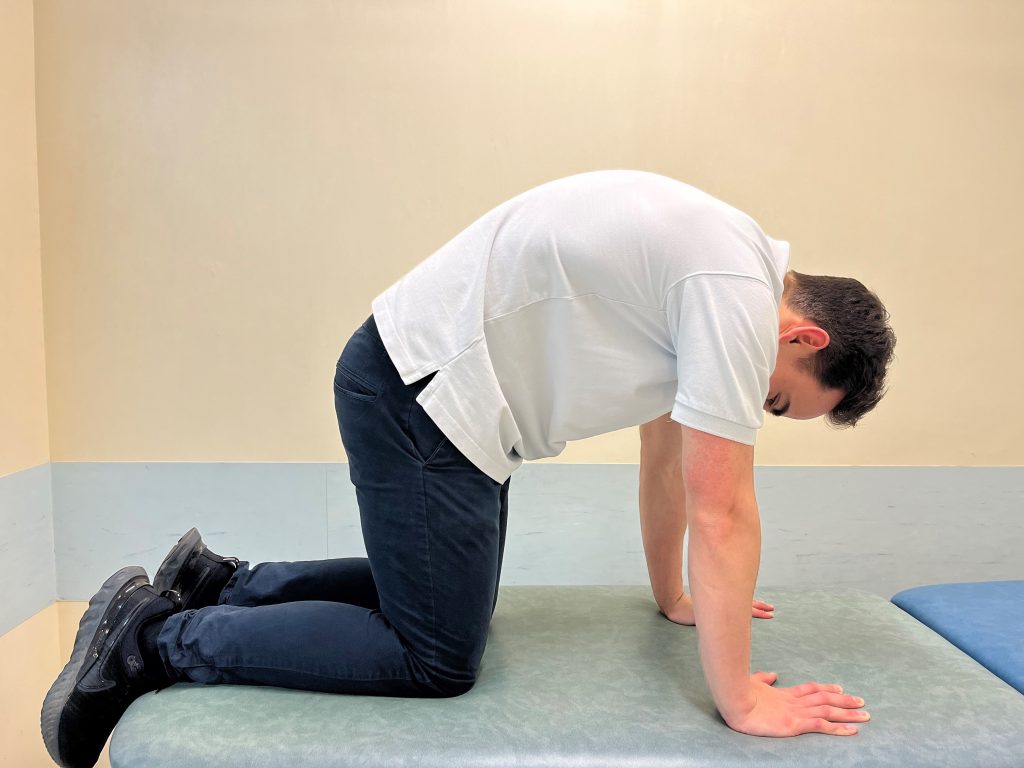
Start in 4 point kneeling with your weight distributed evenly between your hands and knees.
Lift the upper back up creating a curve.
Hold for 5 seconds then return to the start position.
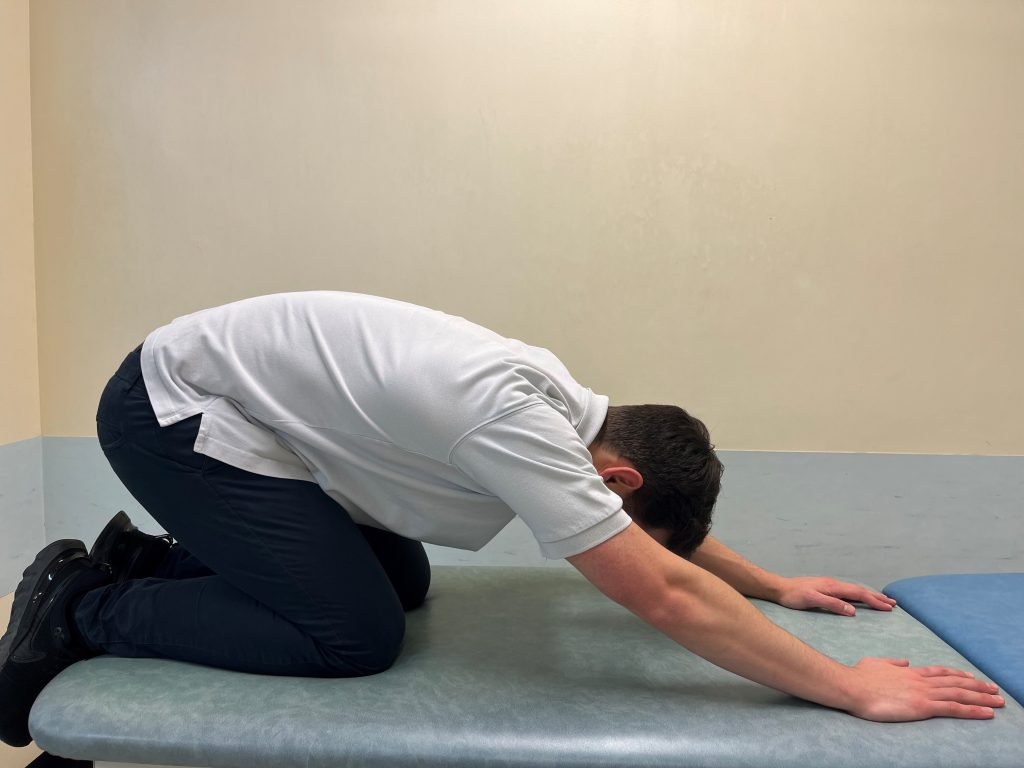
Exercise 6: Child’s pose
In kneeling, keep your bottom in contact with your heels throughout the exercise.
Tighten your stomach muscles and slowly walk your hands out in front of you until you feel a stretch in your upper and lower back.
Hold for 5-10 seconds and slowly walk hands back in.
What about work?
Stay active at work or return to work as soon as possible; if necessary, with temporarily modified duties. This helps you keep your ‘work fitness’ and prevents your body getting weak, which can prolong your pain.
You do not have to be pain free to return to or remain at work.
Maintaining all normal activities including work improves your chance of recovery by keeping you moving.
Working in discomfort is unlikely to lead to any long-term problems and can reduce the risk of re-injury’. It also helps to regain any strength that has been lost in the early stages when the pain stopped you moving normally. The more time spent away from work, the greater the risk to your long-term quality of life.
You may not be able to return to your full duties straight away. It may take a short period of adjustment before you resume full duties. Often people are concerned about heavy jobs or jobs that require staying in the same position for a long time. You can discuss this with your manager and a short period of modified duties may be possible.
What should I do if I am still experiencing problems?
If you are unable to agree on restricted roles with you manager or you are still having problems (despite following this advice): your occupational health team can help.
The occupational health team can advise you on how to bridge the gap to help you return to normal activities. You can also gain access to the occupational Health physiotherapy team.
Self-referral portal
Staff can self-refer into Newcastle Occupational Health Service by completing an online self-referral.
The online referral portal will replace the downloadable self-referral forms that staff have previously completed and emailed across to the service.
Find out more and for further help in completing a self-referral.
Management referral
Management referrals will be completed and processed using an online system which we will be launching soon.
We will be contacting managers shortly in order to onboard them onto the system.
Online group seminar
The Newcastle Occupational health team have created a 1-hour online group educational seminar designed to give you tools and ideas to support you with managing back pain.
Book a slot on one of these sessions